New Energy Vehicle Electric Drive and Power Domain Industry Report, 2023
Electric drive and power domain research: electric drive assembly evolves to integration and domain control
To follow the development trend for electrified and lightweight vehicles, new energy vehicle electric drive assembles tend to be highly integrated. At present, the mainstream electric drive system integration route is three-in-one technology, integrating motor, ECU and reducer. The technology has overall been mature.
In terms of the development trend of all-electric drive assembly, electric control system integration tend to be X-in-one deep integration in the future, overall evolving to the "3+3+X platform" (three-in-one electric drive + three-in-one charging and distribution + BMS/VCU/PTC/TMM, etc.). "Six-in-one" products further integrate BMS, VCU, etc. to constitute "seven-in-one" or "eight-in-one" products which combine vehicle thermal management system to become "nine-in-one" or "ten-in-one" products, achieving deep integration of mechanical and power components.
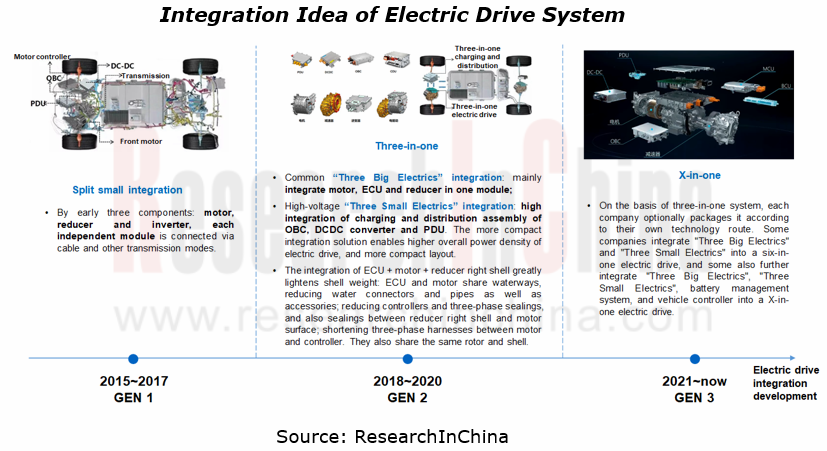
OEMs work harder to independently develop and manufacture electric drive systems.
At present, electric drive assembles are mainly manufactured by automotive OEMs themselves or provided by third-party suppliers. Automakers that manufacture by themselves are led by Tesla, NIO, BYD, Volkswagen, etc. Some OEMs are also increasing their self-sufficiency ratio. For example, Great Wall Motor which initially adopted UAES' electric drive systems is shifting to independent manufacture through its subsidiary Svolt; Geely which used Nidec’s electric drive systems in early days now begins to independently manufacture through its arm VREMT. Electric drive system suppliers mainly include international giants like Bosch, Magna, BorgWarner, Nidec and ZF, and multiple Chinese suppliers such as Inovance Technology, Jing-Jin Electric Technologies, Huawei, and Jee Technology.
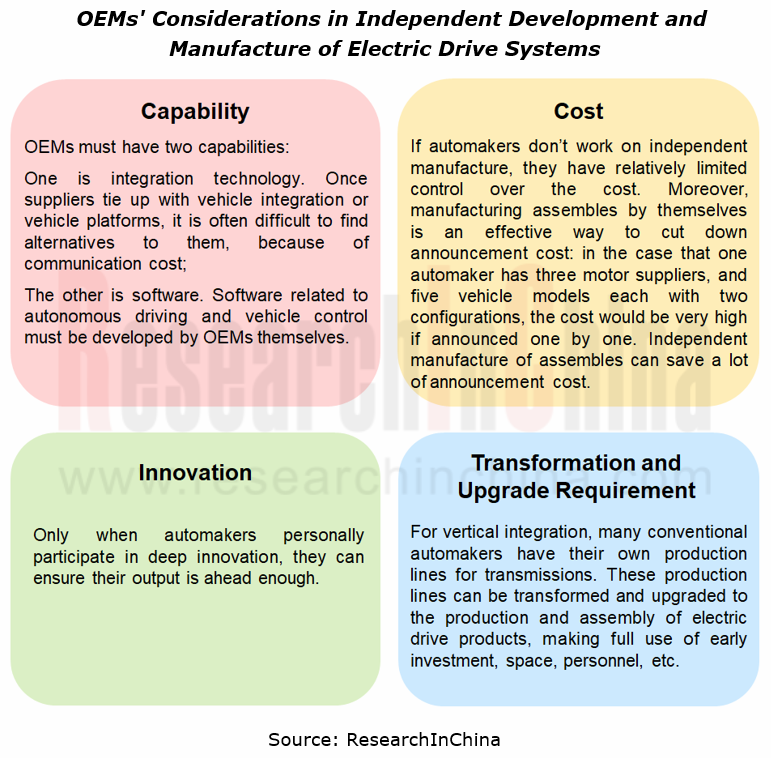
OEMs' greater need for self-development has brought about change in conventional electric drive assembly supply and demand relationships.
From OEM’s perspective, electric drive system is a highly customized product, and automakers have different position, power and performance requirements for their vehicle models, which needs to be matched with vehicle systems. Self-developing electric drives therefore can save upstream and downstream communication cost and investment cost for OEMs, and also accelerates model iteration;
From third-party supplier’s perspective, their cost advantage is great. Whether it is for lower cost, faster iteration and lower rejection rate in production, or platform-based production line utilization, third-party suppliers can share cost and thus gain scale cost advantages by supplying to multiple automakers.
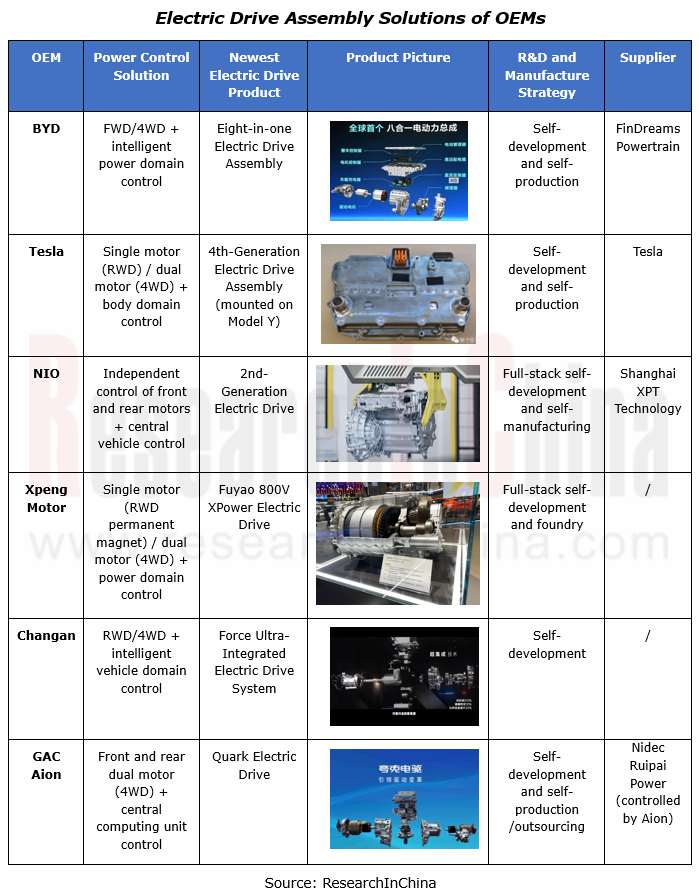
Considering position of their model vehicles, automakers have different technology routes and performance requirements for vehicle power. For example, for mid-to-high-end models that are less sensitive to cost, the priority is given to performance and reliability of electric drive products, so OEMs prefer self-supply system; as for low-to-mid-end models with low value, highlighting procurement cost, self-production costs much for OEMs, and has no cost advantage compared to third-party supply, so OEMs may prioritize third-party supply. In the future, in the electric drive system market OEMs and third-party suppliers will coexist for a long time, and OEMs dominate in the mid-to-high-end model market while third-party suppliers lead in the low-to-mid-end model market.
Domain control for electric drive systems: evolve from independent power domains to cross-domain fusion and central integration
In the evolution from X-in-one controllers to power domain controllers, at first all powertrain control modules were integrated into a single PCB (multiple master chips/single control board), and then they share a single controller for software algorithm fusion (single master chip/single control board).
In the trend for X-in-one integration, based on original VCU, hardware and software of powertrain control modules such as VCU, BMS, MCU and DC/DC are integrated into one controller through chip integration and algorithm fusion to form a power domain control platform, and higher performance chips are used to support vehicles to enable SOA. Power domain controller will realize centralization of powertrain control decision ends, while sensor and actuator functions will be decentralized to each ECU.
DCU3000, a vehicle power domain controller launched by Tianjin Yidingfeng Powertrain, integrates control functions such as VCU, BMS, and thermal management. This product complies with AUTOSAR 4.2 standard, and supports RTE and non-RTE interfaces at the application layer. It also supports such functions as UDS fault diagnosis and 100M vehicle Ethernet communication. It allows for customization of bootloader brushing process and parameters, and supports FOTA backup and refresh function. It is suitable for battery electric vehicles and hybrid electric vehicles with 12V power supply systems.
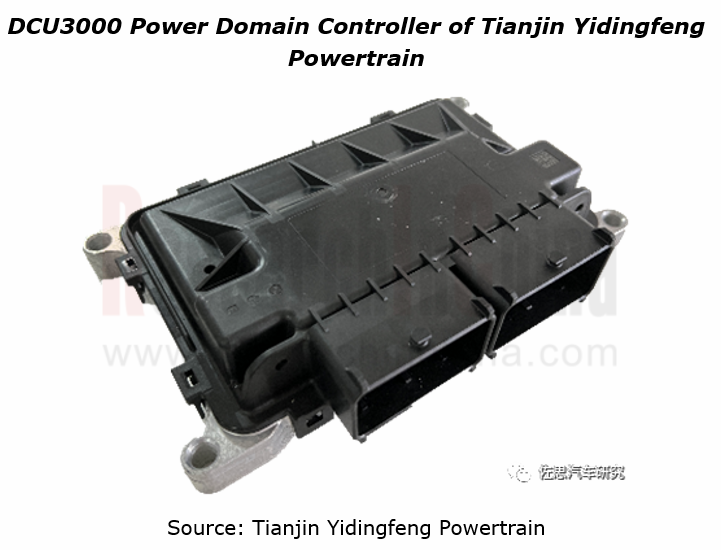
As OEMs announce their next-generation E/E architectures, vehicle controllers will be further integrated and reduced, and ultimately form a "central computing + zone control" architecture. In the evolution trend of EEA, power domains will be further integrated with other functional domains for cross-domain fusion, including power + body + chassis three-domain fusion, power domain + chassis domain fusion and other solutions, so as to smoothly evolve to centralized architecture. Examples include ZF's vehicle motion domain (VMD) controller, UAES' VMD controller VCU8.5, and SemiDrive's intelligent vehicle control unit VHPC.
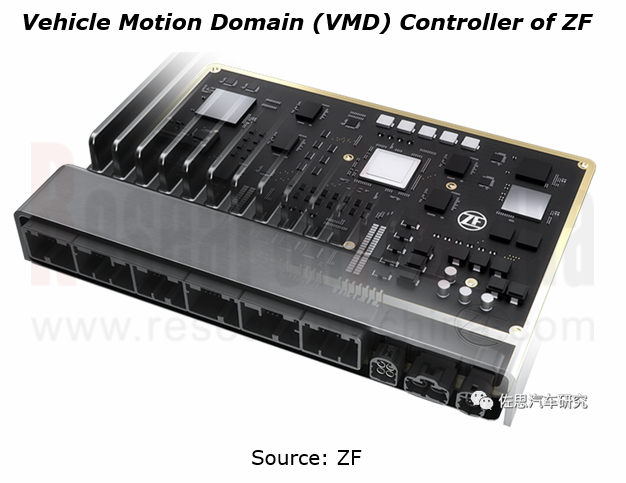
As a central computer, ZF's VMD controller is designed to integrate vehicle functions in different domains and supports stand-alone functions in a single unit. It coordinates chassis and vehicle functions from a single unit and integrates vehicle body control functions without the need of additional ECUs while reducing complexity. The VMD controller is adaptable for all types of chassis platforms, vehicle motion and body functions, next-generation software defined cars and future domain and zone E/E architectures.
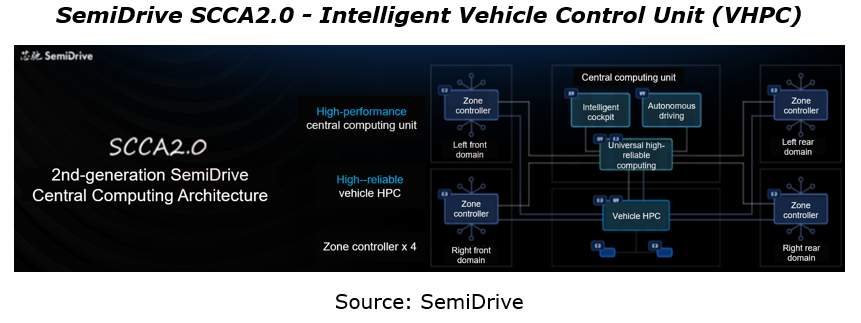
In April 2023, SemiDrive first introduced SCCA2.0, its future-oriented central computing architecture, to provide underlying references for OEMs. This architecture contains six core units which are interconnected via 10G/1Gbps high-performance vehicle Ethernet, and adopts redundancy architecture, ensuring low-latency high-traffic data exchange and security. Wherein, the intelligent vehicle control unit (VHPC) is a chassis domain + power domain integrated controller, mainly responsible for chassis and power integration and intelligent control. In terms of hardware, the VHPC uses SemiDrive's G9 processor and E3 MCU, with total CPU compute up to 300KDMIPS.
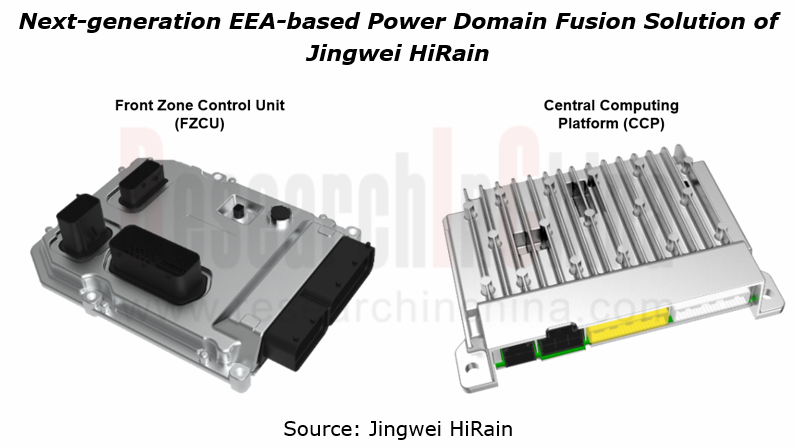
In the evolution of automotive E/E architecture, Jingwei HiRain has designed and developed products based on future mainstream centralized architecture. In the 2023 New Product Launch, it announced the new products: Central Computing Platform (CCP) and Zone Control Unit (ZCU).
ZCU integrates such functions as body comfort domain control, power system control, air conditioning thermal management, chassis control, primary power distribution, secondary power distribution, isolation switch, gateway, and OTA, which are located in the front/left/right/rear of the cabin. Thereof, FZCU is responsible for I/O signal acquisition and control in body comfort domain, new energy power domain, partial chassis domain and air conditioning thermal management, and it mainly integrates some functions of VCU, such as vehicle thermal management and high-voltage interlock.
CCP, a core computing unit in body and power domains, integrates a range of functions such as central gateway, body comfort domain control, new energy vehicle power control, air conditioning thermal management, vehicle energy management, full-volume data acquisition, OTA update, and SOA services. It complies with ISO21434 international cybersecurity standards and ASIL D functional safety requirements. Currently this product has completed R&D, test and small-batch production, and has built mass production and supply cooperation with 4 mainstream automakers in China. It will be produced in quantities and delivered by the end of 2023.
In terms of power domain controller development, in general OEMs directly take a part in solution design as it involves vehicle control strategy, and differentiation and personalization of vehicle models. As for domain controller development, the current main cooperation mode is that OEMs self-develop core software and third parties supply hardware/underlying driver software.
Another mode is that OEMs and third parties jointly develop. OEMs can participate in development of control boards, software bottom layer, application layer, integration test, etc. according to their own development capabilities, such as hardware, bottom layer, application layer, and integrated development and test of VCU and BMS.
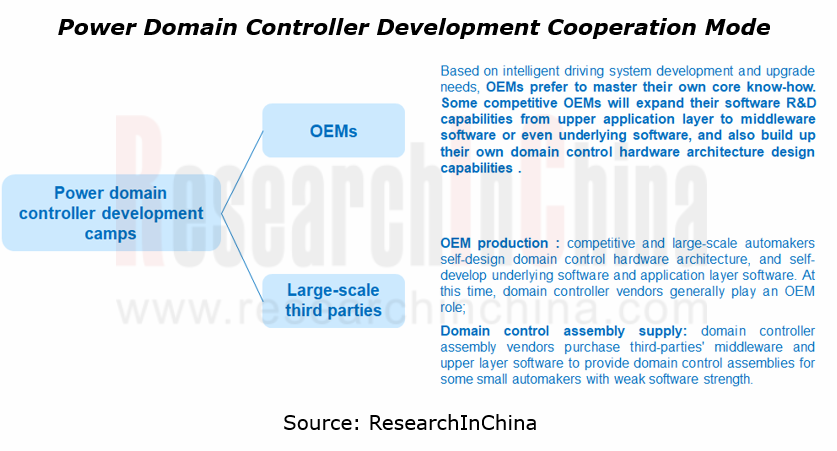
On the whole, X-in-one integration of electric drive system pushes originally independent and distributed powertrain control modules towards centralized integration of power domain controllers, and facilitates the integration of powertrain system control from module to system, and then to overall solution. In the future, whether it is electric drive assembly market or power domain controller market, or cross-domain fusion and future central computing + zone control mode in the evolution to next-generation EEA, all the parties in the whole industry chain should work together to promote the rapid development of automotive electric drive assembly and power domain controller in China, and realize win-win cooperation.
New Energy Vehicle Electric Drive and Power Domain industry Report, 2024
OEMs lead the integrated development of "3 + 3 + X platform", and the self-production rate continues to increase
The electric drive system is developing around technical directions of high integratio...
Global and China Automotive Smart Glass Research Report, 2024
Research on automotive smart glass: How does glass intelligence evolve?
ResearchInChina has released the Automotive Smart Glass Research Report 2024. The report details the latest advances in d...
Passenger Car Brake-by-Wire and AEB Market Research Report, 2024
1. EHB penetration rate exceeded 40% in 2024H1 and is expected to overshoot 50% within the yearIn 2024H1, the installations of electro-hydraulic brake (EHB) approached 4 million units, a year-on-year ...
Autonomous Driving Data Closed Loop Research Report, 2024
Data closed loop research: as intelligent driving evolves from data-driven to cognition-driven, what changes are needed for data loop?
As software 2.0 and end-to-end technology are introduced into a...
Research Report on Intelligent Vehicle E/E Architectures (EEA) and Their Impact on Supply Chain in 2024
E/E Architecture (EEA) research: Advanced EEAs have become a cost-reducing tool and brought about deep reconstruction of the supply chain
The central/quasi-central + zonal architecture has become a w...
Automotive Digital Power Supply and Chip Industry Report, 2024
Research on automotive digital power supply: looking at the digital evolution of automotive power supply from the power supply side, power distribution side, and power consumption side
This report fo...
Automotive Software Business Models and Suppliers’ Layout Research Report, 2024
Software business model research: from "custom development" to "IP/platformization", software enters the cost reduction cycle
According to the vehicle software system architecture, this report classi...
Passenger Car Intelligent Steering Industry Research Report, 2024
Intelligent Steering Research: Steer-by-wire is expected to land on independent brand models in 2025
The Passenger Car Intelligent Steering Industry Research Report, 2024 released by ResearchInChina ...
China Passenger Car Mobile Phone Wireless Charging Research Report, 2024
China Passenger Car Mobile Phone Wireless Charging Research Report, 2024 highlights the following:Passenger car wireless charging (principle, standards, and Qi2.0 protocol);Passenger car mobile phone ...
Automotive Smart Exteriors Research Report, 2024
Research on automotive smart exteriors: in the trend towards electrification and intelligence, which exteriors will be replaced by intelligence?
The Automotive Smart Exteriors Research Report, 2024 ...
Automotive Fragrance and Air Conditioning System Research Report, 2024
Research on automotive fragrance/air purification: With surging installations, automotive olfactory interaction is being linked with more scenarios.
As users require higher quality of personalized, i...
Intelligent Vehicle Multi-Domain Computing Industry Report, 2024
Multi-Domain Computing Research: A Summary of Several Ideas and Product Strategies for Cross-Domain Integration
1. Several ideas and strategies for cross-domain integration of OEMs
With the increasi...
Analysis on Xiaomi Auto's Electrification, Connectivity, Intelligence and Sharing, 2024
Research on Xiaomi Auto: Xiaomi Auto's strengths and weaknesses
Since the release of SU7, Xiaomi delivered 7,058 units and 8,630 units in April and May, respectively, and more than 10,000 units in bo...
ADAS and Autonomous Driving Tier 1 Suppliers Research Report, 2024 - Foreign Companies
Research on foreign ADAS Tier 1 suppliers: make all-round attempts to transform and localize supply chain and teams.???
1. Foreign ADAS Tier 1 suppliers fall behind relatively in development of inte...
Research Report on Passenger Car Cockpit Entertainment--In-vehicle Game, 2024
1. In-vehicle entertainment screens are gaining momentum, and Chinese brands rule the roost.
In-vehicle entertainment screens refers to display screens used for entertainment activities such as viewi...
Body (Zone) Domain Controller and Chip Industry Research Report,2024
Research on body (zone) domain controller: an edge tool to reduce vehicle costs, and enable hardware integration + software SOA.
Integration is the most important means to lower vehicle costs. Funct...
China Charging/Swapping (Liquid Cooling Overcharging System, Small Power, Swapping, V2G, etc) Research Report, 2024
Research on charging and swapping: OEMs quicken their pace of entering liquid cooling overcharging, V2G, and virtual power plants.
China leads the world in technological innovation breakthroughs in ...
Autonomous Driving SoC Research Report, 2024
Autonomous driving SoC research: for passenger cars in the price range of RMB100,000-200,000, a range of 50-100T high-compute SoCs will be mass-produced.?? According to ResearchInChina’s statistical a...